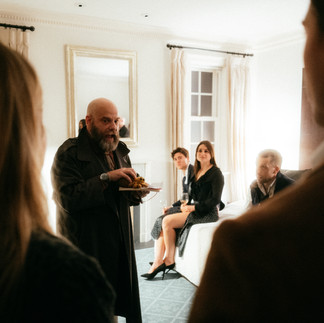From Ideas to Impact: Crafting Immersive Brand Experiences That Resonate
- Natalia Amoroso
- Feb 24
- 3 min read
Updated: Feb 27

Experiential marketing has the power to transform a brand’s presence, engage audiences on a deeper level, and create lasting memories that drive conversions. But in a world where consumers are bombarded with events, activations, and brand experiences, how do you stand out?
Drawing from the success of Murder at the Manor, a luxury real estate activation designed to reimagine the traditional open house, this guide breaks down the key elements of crafting and executing innovative experiential marketing strategies.
1. Start with a Clear Objective
Before you dive into the creative elements, define the why behind your experiential marketing campaign. Are you looking to:
Generate brand awareness?
Drive sales or leads?
Position your company as an industry leader?
Strengthen relationships with existing clients or partners?
For Murder at the Manor, the goal was twofold: showcase an exclusive listing in an engaging, unforgettable way while positioning the real estate brand as an innovator in the industry. By turning a luxury home into a live-action mystery experience, the event seamlessly combined storytelling with sales strategy.
2. Develop a Concept That Resonates
Your concept should not only reflect your brand’s identity but also captivate your target audience. Think beyond traditional events—immersive themes, interactive elements, and unexpected surprises can elevate your activation. Consider these brainstorming prompts:
How can you blend entertainment with your product/service?
Can you integrate gamification or participatory elements?
Does your event tap into cultural trends or pop culture references?
A live-action mystery game turned an open house into an interactive storytelling experience, making the attendees part of the narrative rather than passive guests.
3. Leverage Multi-Sensory Engagement
Great experiential marketing is immersive—it should stimulate multiple senses and evoke emotions. Think about:
Visuals: High-impact design, lighting, and aesthetics.
Sound: Custom soundscapes, live music, or audio storytelling.
Taste & Smell: Themed cocktails, gourmet food pairings, or scented environments.
Touch: Interactive displays, hands-on activities, or exclusive merchandise.
A vintage-inspired setting, period-costumed actors, curated cocktails, and atmospheric lighting all worked together to transport guests into the world of a classic whodunit.
4. Build Shareability & Digital Extensions
To amplify your reach, ensure your activation has elements that encourage user-generated content and digital engagement. Some strategies include:
Branded photo ops: Set up Instagram-worthy moments.
Hashtags & social challenges: Encourage attendees to share their experiences online.
Live-streaming or exclusive content: Extend the experience to a wider audience.
Guests were encouraged to document their experience through a branded hashtag, while a behind-the-scenes video recapped the night for online audiences.
5. Nail the Execution
A brilliant idea can fall flat without seamless execution. Consider:
Detailed planning & production timelines
Staffing & on-site logistics
Contingency plans for unforeseen issues
Guest experience flow (from entry to exit)
Everything from the invitation process to the event finale was meticulously planned to ensure smooth transitions, guest engagement, and an unforgettable night.
6. Measure Success & Optimize
Your experiential marketing event shouldn’t end when the last guest leaves. Assess its impact through:
Post-event surveys & feedback
Social media impressions & engagement metrics
Lead generation & conversion tracking
PR & media coverage
Follow-up conversations with attendees confirmed that the event led to increased interest in the property and strengthened Heaps Estrin’s reputation for forward-thinking marketing.
Final Thoughts
Experiential marketing isn’t just about throwing an event—it’s about crafting a strategic, immersive experience that builds deeper connections with your audience. By focusing on clear objectives, compelling storytelling, multi-sensory engagement, and flawless execution, you can create moments that resonate long after the event ends.
Looking to develop an innovative experiential campaign for your brand? Let’s bring your vision to life!





















